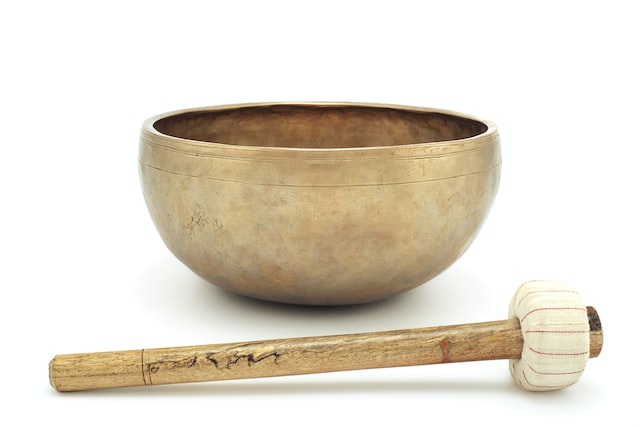Tibetan singing bowls, also known as Tibetan sound bowls and Buddhist prayer bowls are extremely popular accessories. These unique metal bowls are known for their calming sound and are widely used in sound therapy, meditation, and other forms of cultural, religious, and meditative practices all across the world, particularly in areas with Buddhist influences. Along with being a meditation and therapy accessory, these Himalayan singing bowls are also commonly used as household decor. However, despite its popularity, very few people know how to use a singing bowl!
You can technically make any random bowl sing by hitting it but what sets this Buddhist Tibetan singing bowl apart is that the sound it produces is unique and calming. Let’s be honest here, although you can hit any metal bowl to produce a sound, which is not the case for the Tibetan singing bowl.
Another thing that sets the Tibetan singing bowl apart from other bowls is the techniques involved in making this bowl sing. Yes, there is more than one technique to make a Tibetan bowl, sing. The tone and sound produced by this amazing artifact will change depending on the technique you use. So what are these techniques?
How To Use A Sound Bowl/ Tibetan Singing Bowl?
This is one of the most frequently asked questions when it comes to the singing bowl – not the price, not the purpose, but how to use a singing bowl. However, it is not that hard to use a singing bowl. With some practice, almost everybody can use this Tibetan Buddhist Tibetan bowl.
There are three techniques to use these musical bowls and all of them have varying degrees of difficulty. So what are these techniques?
Method 1: Striking The Bowl

Striking the bowl is one of the simplest and easiest methods to use the Tibetan singing bowl. All you need to do is strike the rim of the bowl with the mallet lightly. Once you do this, you will hear a pleasant sound. Now the sound of the singing bowl will vary depending on the force you strike with and the angle of the strike. As such, it may take a while for you to find out the best perfect angle to produce a sound that harmonizes with you.
In essence, the steps in this method are:
- Hold the bowl in your non-dominant hand’s palm
- Hold the mallet in your dominant hand and strike the bowl gently with the padded side/softer side
- Let the vibrations from the sound dissipate completely before striking again to get the best sounds.
As a side note, you need to be careful about the force you strike the bowl with. Although Tibetan singing bowls are made from long-lasting copper alloy, the quality of the sound will degrade if you hit it too hard.
Method 2: Rimming

Rimming is undoubtedly harder than simply striking the singing bowl. In this method, rather than simply striking the bowl with a mallet, you rub the edge of the opening with the soft end of a mallet to produce a reverberating soft continuous calming ringing from the Tibetan singing bowl. This song from the Tibetan singing bowl can further vary depending on the pressure applied to the mallet while rubbing the edge, along with how fast you move the mallet.
So while you only had to worry about the force you apply in the striking method, you also need to control the force along with speed.
To properly use the singing bowl using the rimming method, you will need to
- Sit in a relaxed position and maintain natural breath
- Hold the bowl in the palm of your non-dominant hand
- Grip the mallet between your index and thumb and rest it gently across the palm of your dominant hand while letting it droop downwards
- Lightly strike the bowl on the mid-exterior on the edge to start the vibrations
- Circle the softer end of the mallet (the one drooping down) in a clockwise direction immediately after striking the bowl softly without breaking the contact using your full arm movement in a swift movement
- Slow down your speed once you start hearing a soft feminine overtone.
As you continue to the rim, the feminine overtone will build up over time and will reverberate with the initial ring from the singing bowl creating a unique harmonic sound. While doing this, it is necessary to constantly apply pressure to the mallet as the sound will change or even stop completely depending on the amount of pressure you apply.
This method of using the Tibetan Buddhist singing bowl is a great way to temper your will, consistency, and patience.
Method 3: Water Bowl

As the name suggests, this method of using a Tibetan singing bowl includes adding water inside the bowl. There are two distinct techniques that you can use in this method and one of them is simpler than the other method. The first method is simply to add water to the singing bowl and use either the rimming or striking method to make the bowl ring. Depending on the amount of water, the sound of the bowl will vary.
The second technique is a bit more complicated than this and to perform this technique, you will need to,
- Add a three-quarter cup of water to the bowl
- While adding the bowl, be careful to not let the water get on the rim or outside of the bowl
- Play the bowl using the rimming method
- Move the mallet away from the bowl and let it sing
- Tilt the bowl slightly towards the rim and continue tilting until the water begins to swirl
Using the swirling technique of the water bowl technique will create a unique sound reminiscent of the dolphin’s cry. That said regardless of the method you use, be sure to not dry the bowl properly after using this method. Although singing bowls do not degrade with water, not drying the bowl properly after use can reduce the quality of the sound over time.
These are the three primary methods to use the singing bowls. But the question now is – why should we even use the singing bowls? If there are benefits to using singing bowls, there should also be some risks right?
Side note: You can also play singing bowls and compose great music using this method.
What Are The Benefits And Risks Of Using Tibetan Singing Bowls?

To answer the question that we asked a bit earlier, there are indeed benefits and risks that you need to be wary about while you use Tibetan Buddhist singing bowls. That said, we have already covered the benefits and dangers of using singing bowls in detail, do check out for more information. Here we will glance over the primary benefits and risks that you need to note to play Tibetan singing bowls.
Benefits to use Buddhist Singing Bowls
- It relaxes your mind and body.
- The singing bowl sound therapy from singing bowls can stimulate your brain waves.
- The vibrations aid in reducing pain.
- The sound along with the vibrations can reduce anxiety and builds up inner peace.
- The sound from a singing bowl is perfect for meditation.
Risks and dangers of using Tibetan Sound Bowl
- You need to be wary if you use a pacemaker as the vibrations from the bowl can interfere with your heartbeat if used close to the heart.
- If used directly over the head, singing bowls can induce headaches in some people.
- Tibetan singing bowls as a whole can be harmful in contact with someone with a metal allergy, especially those related to copper and its alloys.
In The End,
Tibetan singing bowls are a well-known accessory and artifact used as an aid in meditation and a key component in many forms of sound therapy, along with accessories such as Japa Mala and Wrist Malas. The sound from this meditative bowl is soothing to the ears and is among the best tools for getting into deeper meditation. As you may have noticed here, there are multiple ways to use this Buddhist sound bowl, and depending on the method, the sound will vary.
We hope you found this helpful. And as always, thank you for reading till the end.
FAQ
Q: How do you use a singing bowl for beginners?
A: The best way to use singing bowls for beginners is to strike them softly with the mallet provided. The produced singing bowl sound will change depending on the force and angle of the strike and it may take a while to find the perfect angle and force to get your desired sound/ring.
Q: What do you do with a Tibetan Singing Bowl?
A: The primary use for the singing bowl is meditation but besides this, you can also use it for sound therapy, sound baths, or simply as decor.
Q: Do you put water in singing bowls?
A: The decision to put water in singing bowls will be entirely up to you. If you want a more muffled and deep tone for your meditation, then you should put water. However, you need to be wary about not spilling the water and drying the bowls properly after using Tibetan singing bowls with water.
Q: How to use Tibetan singing bowls for meditation?
A: To use Tibetan singing bowls for meditation, you will need to hold the bowl in the palm of your non-dominant hand. Tap the outer rim of the bowl with your mallet. The chimes along with the vibrations produced by singing bowls can aid you to get into deeper meditation quicker.

